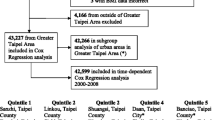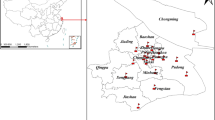Abstract
Recent time series studies have indicated that daily mortality and morbidity are associated with particulate matters. However, about the relative effects and its seasonal patterns of fine particulate matter constituents is particularly limited in developing Asian countries. In this study, we examined the role of particulate matters and its key chemical components of fine particles on both mortality and morbidity in Beijing. We applied several overdispersed Poisson generalized nonlinear models, adjusting for time, day of week, holiday, temperature, and relative humidity, to investigate the association between risk of mortality or morbidity and particulate matters and its constituents in Beijing, China, for January 2005 through December 2009. Particles and several constituents were associated with multiple mortality or morbidity categories, especially on respiratory health. For a 3-day lag, the nonaccident mortality increased by 1.52, 0.19, 1.03, 0.56, 0.42, and 0.32 % for particulate matter (PM)2.5, PM10, K+, SO4 2−, Ca2+, and NO3 − based on interquartile ranges of 36.00, 64.00, 0.41, 8.75, 1.43, and 2.24 μg/m3, respectively. The estimates of short-term effects for PM2.5 and its components in the cold season were 1 ~ 6 times higher than that in the full year on these health outcomes. Most of components had stronger adverse effects on human health in the heavy PM2.5 mass concentrations, especially for K+, NO3 −, and SO4 2−. This analysis added to the growing body of evidence linking PM2.5 with mortality or morbidity and indicated that excess risks may vary among specific PM2.5 components. Combustion-related products, traffic sources, vegetative burning, and crustal component and resuspended road dust may play a key role in the associations between air pollution and public health in Beijing.




Similar content being viewed by others
References
Becker S, Dailey LA, Soukup JM, Grambow SC, Devlin RB, Huang Y-CT (2005) Seasonal variations in air pollution particle-induced inflammatory mediator release and oxidative stress. Environ Health Perspect 113:1032–1038
Bell ML, Ebisu K, Peng RD, Walker J, Samet JM, Zeger SL et al (2008) Seasonal and regional short-term effects of fine particles on hospital admissions in 202 US counties, 1999-2005. Am J Epidemiol 168:1301–1310
Bell ML, Ebisu K, Peng RD, Samet JM, Dominici F (2009) Hospital admissions and chemical composition of fine particle air pollution. Am J Respir Crit Care Med 179:1115–1120
Burnett RT, Brook J, Dann T, Delocla C, Philips O, Cakmak S (2000) Association between particulate- and gas-phase components of urban air pollution and daily mortality in eight Canadian cities. Inhal Toxicol 12(suppl 4):S15–S39
Dockery DW, Pope CA III, Xu X, Spengler JD, Ware JH, Fay ME (1993) An association between air pollution and mortality in six U.S. cities. N Engl J Med 329:1753–1759
Fairley D (2003) Mortality and air pollution for Santa Clara County, California, 1989–1996. In: Revised Analyses of Time-Series Studies of Air Pollution and Health. Special Report. Boston:Health Effects Institute, pp 97–106
Garrett P, Casimiro E (2011) Short-term effect of fine particulate matter (PM2.5) and ozone on daily mortality in Lisbon, Portugal. Environ Sci Pollut Res 18:1585–1592
Health Effects Instiute (2003) Revised analyses of the National Morbidity, Mortality, and Air Pollution Study (NMMAPS), part II. In: Revised Analyses of Time-Series Studies of Air Pollution and Health. Special Report. Boston:Health Effects Institute, pp 9–72. Available: http://www.healtheffects.org/Pubs/TimeSeries.pdf
Ito K, Mathes R, Ross Z, Nadas A, Thurston G, Matte T (2011) Fine particulate matter constituents associated with cardiovascular hospitalizations and mortality in New York City. Environ Health Perspect 119:467–473
Katsouyanni K, Touloumi G, Spix C, Schwartz J, Balducci F, Medina S et al (1997) Short-term effects of ambient sulphur dioxide and particulate matter on mortality in 12 European cities: results from time series data from the APHEA project. Air Pollution and Health: a European Approach. BMJ 314:1658–1663
Li P, Xin J, Wang Y, Wang S, Li G, Pan X et al (2013a) The acute effects of fine particles on respiratory mortality and morbidity in Beijing, 2004–2009. Environ Sci Pollut Res 20:6433–6444
Li P, Xin J, Wang Y, Wang S, Li G, Pan X et al (2013b) Time-series analysis of mortality effects from airborne particulate matter size fractions in Beijing. Atmos Environ. doi:10.1016/j.atmosenv.2013.09.004
Liu ZR (2011) The particle matter pollution in Beijing-concentration, variation, composition and sources. PhD thesis, Institute of Atmospheric Physics, Chinese Academy of Sciences, Beijing (in Chinese)
Liu ZR, Wang YS, Liu Q, Hu B, Sun Y (2013) Source apportionment of ambient fine particle from combined size distribution and chemical composition data during summertime in Beijing. Atmos Chem Phys Discuss 13:1367–1397
Mar TF, Norris GA, Koenig JQ, Larson TV (2000) Associations between air pollution and mortality in Phoenix, 1995–1997. Environ Health Perspect 108:347–353
Maykut NN, Lewtas J, Kim E, Larson TV (2003) Source apportionment of PM2.5 at an urban IMPROVE site in Seattle, Washington. Environ Sci Technol 37:5135–5142
Ostro B, Broadwin R, Green S, Feng W-Y, Lipsett M (2006) Fine particulate air pollution and mortality in nine California counties: results from CALFINE. Environ Health Perspect 114:29–33
Ostro B, Feng WY, Broadwin R, Green S, Lipsett M (2007) The effects of components of fine particulate air pollution on mortality in California: results from CALFINE. Environ Health Perspect 115:13–19
Peng RD, Dominici F, Barriuso RP, Zeger SL, Samet JM (2005) Seasonal analyses of air pollution and mortality in 100 US cities. Am J Epidemiol 161:585–594
Peters A, Wichmann HE, Tuch T, Heinrich J, Heyder J (1997) Respiratory effects are associated with the number of ultrafine particles. Am J Respir Crit Care Med 155:1376–1383
Pope CA III, Dockery DW (2006) Health effects of fine particulate air pollution: lines that connect. J Air Waste Manag Assoc 56:709–742
Pope C III, Thun M, Namboodiri M, Dockery DW, Evans JS, Speizer FE et al (1995) Particulate air pollution as a predictor of mortality in a prospective study of U.S. adults. Am J Respir Crit Care Med 151(3 Pt 1):669–674
Schwartz J, Dockery DW, Neas LM (1996) Is daily mortality associated specifically with fine particles? J Air Waste Manag Assoc 46:927–939
Son JY, Lee JT, Kim KH, Jung K, Bell ML (2012) Characterization of fine particulate matter and associations between particulate chemical constituents and mortality in Seoul, Korea. Environ Health Perspect 120:872–878
Styer P, Millan MN, Gao F, Davis J, Sacks J (1995) Effect of outdoor airborne particulate matter on daily death counts. Environ Health Perspect 103:490–497
Sun Y, Zhuang G, Wang Y, Han L, Guo J, Dan M et al (2004) The air-borne particulate pollution in Beijing—concentration, composition, distribution and sources. Atmos Environ 38:5991–6004
Watson JG, Chow JC, Houck JE (2001) PM2.5 chemical source profiles for vehicle exhaust, vegetative burning, geological material, and coal burning in northwestern Colorado during 1995. Chemosphere 43:1141–1151
Wen T, Wang Y, Chang SY, Liu G (2006) On-line measurement of water-soluble ions in ambient particles. Adv Atmos Sci 23:586–592
Xin JY, Wang YS, Tang GQ, Wan LL, Sun Y, Wang YH, Hu B, Song T, Ji DS, Wang WF, Li L, Liu GR (2010) Variability and reduction of atmospheric pollutants in Beijing and its surrounding area during the Beijing 2008 Olympic Games. Chin Sci Bull 55(18):1937–1944. doi:10.1007/s11434-010-3216-2
Xin JY, Wang YS, Wang LL, Tang GQ, Sun Y, Pan YP, Ji DS (2012) Reductions of PM2.5 in Beijing-Tianjin-Hebei urban agglomerations during the 2008 Olympic Games. Adv Atmos Sci 29(6):1330–1342
Zhang K, Wang Y, Wen T, Meslmani Y, Murray F (2006) Properties of nitrate, sulfate and ammonium in typical polluted atmospheric aerosols (PM10) in Beijing. Atmos Res 84:67–77
Zhou J, Ito K, Lall R, Lippmann M, Thurston G (2011) Time-series analysis of mortality effects of fine particulate matter components in Detroit and Seattle. Environ Health Perspect 119:461–466
Acknowledgments
We thank Yang Sun, Dongshen Ji, Guiqian Tang, Lili Wang, and employees of IAP, CAS for their assistance with various aspects of data collection and data preparation. This work is partially supported by the CAS Strategic Priority Research Program Grant No. XDA05100100, the public project of the Beijing Municipal Science and Technology Commission (D09040903670902), the National Natural Science Foundation of China (41021004, 41075103), the Research Subject of State Science and Technology Support Program of China (2012BAJ18B08), the Gong-Yi Program of China Meteorological Administration (GYHY201106034), and the “Meteorological Environment and Health” Special Service Program of National Population and Health Science Data Sharing Platform.
Author information
Authors and Affiliations
Corresponding author
Additional information
Responsible editor: Philippe Garrigues
Rights and permissions
About this article
Cite this article
Li, P., Xin, J., Wang, Y. et al. Association between particulate matter and its chemical constituents of urban air pollution and daily mortality or morbidity in Beijing City. Environ Sci Pollut Res 22, 358–368 (2015). https://doi.org/10.1007/s11356-014-3301-1
Received:
Accepted:
Published:
Issue Date:
DOI: https://doi.org/10.1007/s11356-014-3301-1




